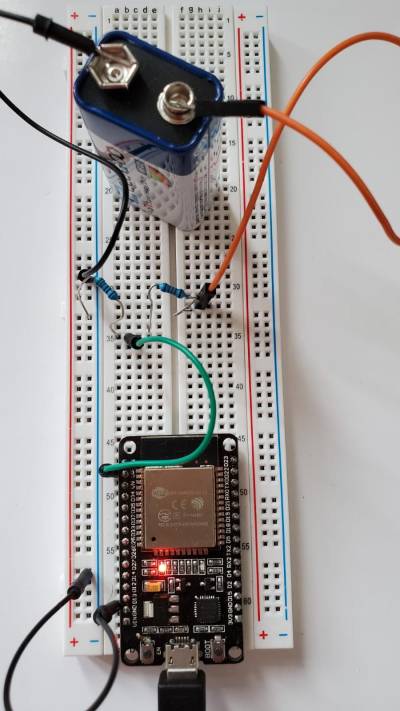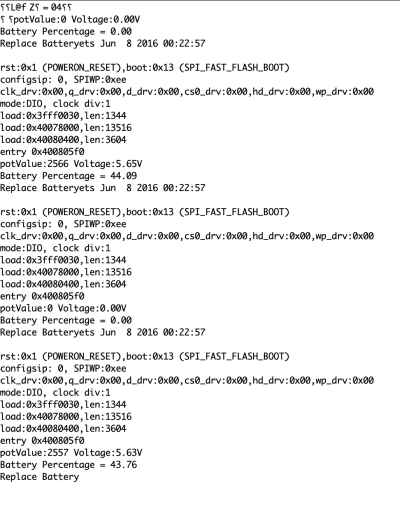amc2022:grouph:link
Table of Contents
Build

| figure 5.1 Setup showing the connections for battery voltage reading on ESP32 |
Schematics

| figure 5.2 Schematic for battery voltage reading |
Code & Description
*//Reading of voltage is done by the Analog Pin reader. *//Because the max input voltage on the pins is 3.3 V we cant directly read the 9V battery voltage. int potPin = A0; // Analog pin has to be ADC 1, because ADC 2 are used by wifi and wont work int potValue; float voltage =0; // float because its a decimal number not integer float battery_percent; void setup() { Serial.begin(115200); { potValue = analogRead(potPin); float voltage = (3.3/4095.0) * potValue * 2.73; *//Resistors and other components can have a varying number of outputs, although they are usually minimal *//additional calibration has to be done in order to get accurate readings *//We have found that the use of a multimeter will help in determining the values that will provide best outcomes *//Because we have different boards, resistors and setups, the final code could have alterations in the calibrating numbers Serial.print("potValue:"); Serial.print(potValue); *//While the serial monitor output can be changed, we are more interested is in the overall result which is transmitted *//to Grafana for easy access Serial.print(" Voltage:"); Serial.print(voltage); Serial.println("V"); battery_percent = mapfloat(voltage, 3.0, 9.0, 0 , 100); // min value cut off at 6V and maximum voltage is 9V if (battery_percent > 100) { battery_percent = 100; } if (battery_percent < 0) { battery_percent = 0; } *//For the conversion between the actual Analog reading to a percentage we use a mapFloat function *//It uses the input range from the analog sensor to produce another set of useful values *//float values will allows to get decimal numbers and a more accurate reading *//We use a the min voltage value, then max voltage value, and min percentage and max percentage *//Then we ask the program to give us the corresponding percentage value within the parameters Serial.print("Battery Percentage = "); Serial.println(battery_percent); if (voltage > 7.0 && voltage < 8.2) // THIS VALUES HAVE TO CHANGE ACCOrDING TO SOURCE {Serial.print("Low bat"); // USE VOLTMETER TO FIND THE ACCURATE VOLTAGE } if (voltage <6.5) //cut-off value is at 5.4V according to specification , we use 6V {Serial.print("Replace Battery"); } delay(1000); *//We have included a notification that will tell us what is going on with the voltage and overall battery status *//We include a parameter that will produce 2 warning signs: *// LOW BAT means that our battery is within 7 to 8.2V *// REPLACE BATTERY means voltage has dropped below 6.5V, number obtained from data sheet } } float mapfloat(float x, float in_min, float in_max, float out_min, float out_max) { return (x - in_min) * (out_max - out_min) / (in_max - in_min) + out_min; } *//here we include the parameters and equation that will serve as the backbone for the mapFloat function above. void loop() { } *// NO LOOP NEEDED,,, ONE VALUE WITH WARNING SHOULD BE DISPLAYED ON GRAFANA
Issues & Characteristics
The actual voltage will not be 100% accurate because the ADC pins have a non-linear behavior. This means according to the Figure # down below that, above a certain threshold the reading will produce equal inputs, thus we consider that from 3 to 3.3V the battery is at a 100% charge.
Additionally we can see that the discharge behavior of the battery we are using, which is a model 6F22 is a curve that has a specific equation, we could find the curve's equation and use it to better represent the discharge values, however since we plan to upgrade our battery system we purposely used a simpler version in our code to achieve good enough results.
 |  |
|---|---|
| figure 5.3 Graph depicting battery discharge for battery model 6F22 9v Source:https://www.mega-piles.com/im/PANASONIC-6F22-9V-CARBONE-ZINC_550.pdf | figure 5.4 Graph depicting ADC voltage VS reading behavior for ESP32 micro controller. Source:https://microcontrollerslab.com/adc-esp32-measuring-voltage-example/ |
Results

amc2022/grouph/link.txt · Last modified: 2022/09/10 00:51 by gustavo001
